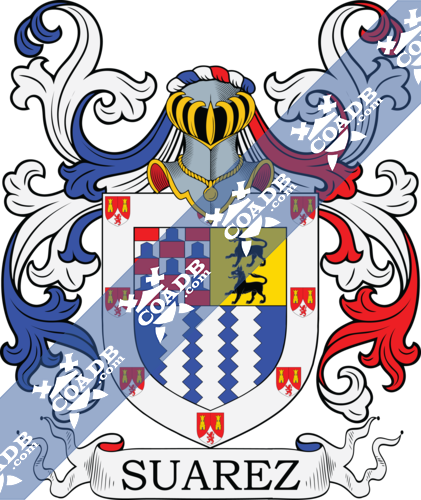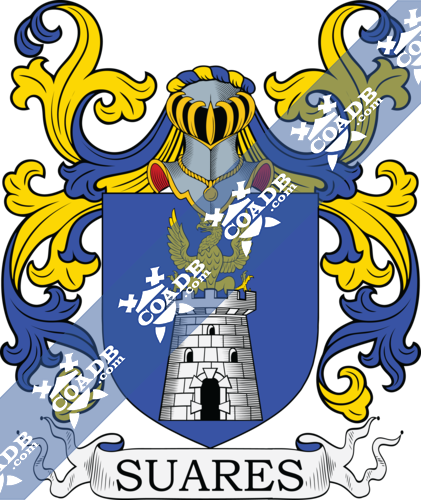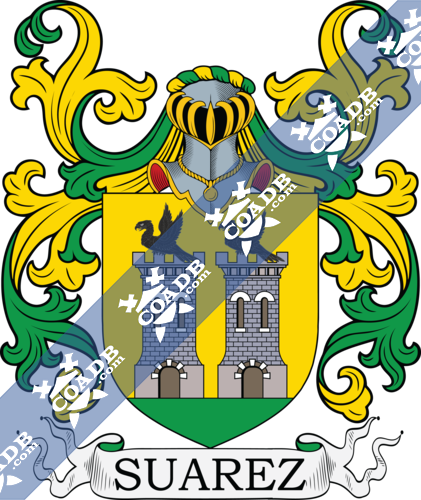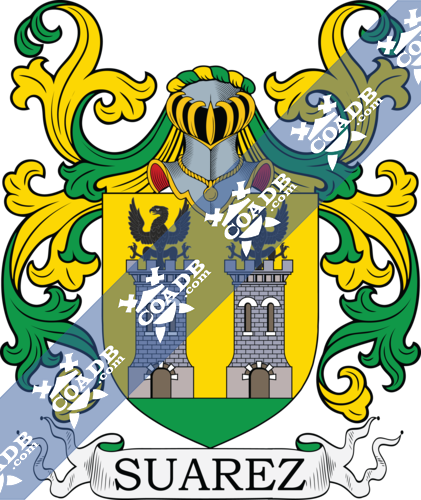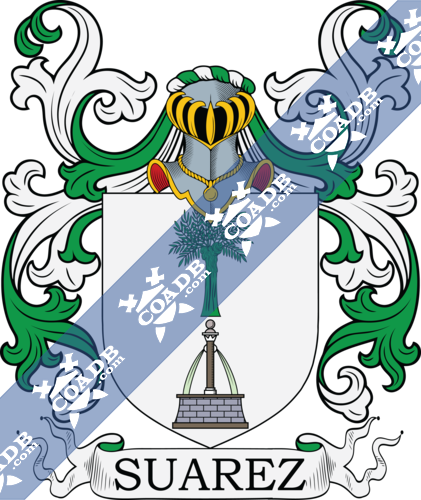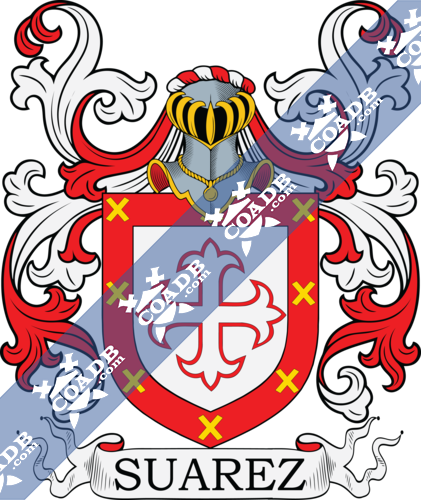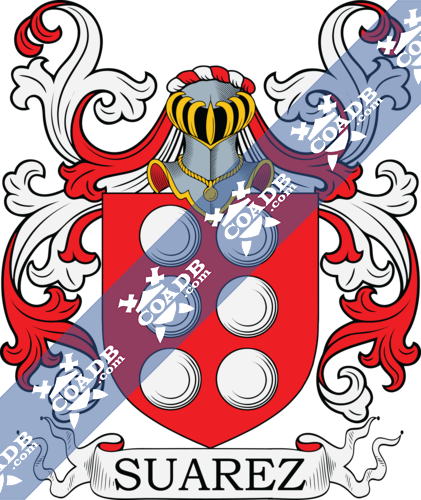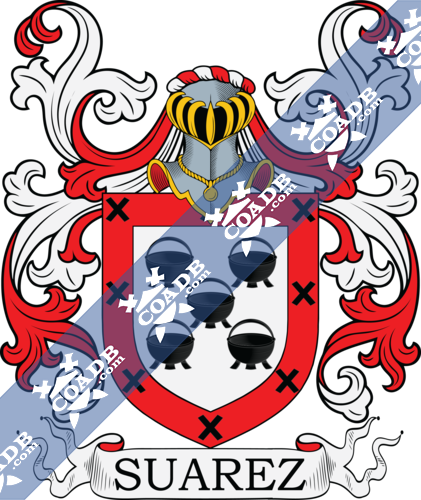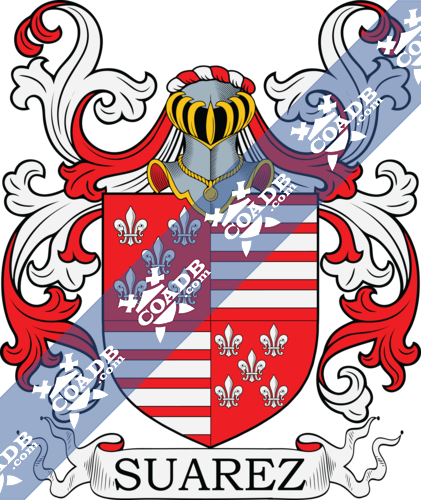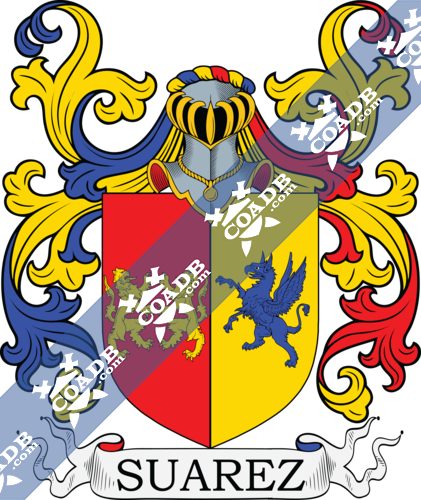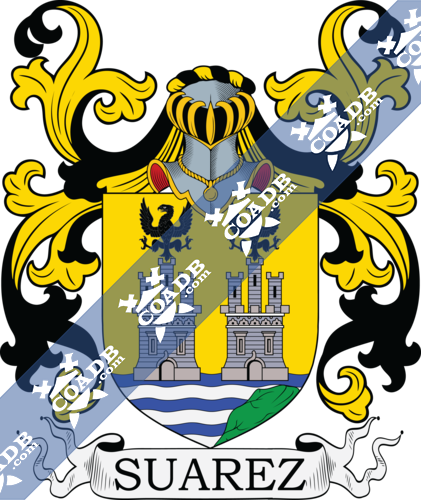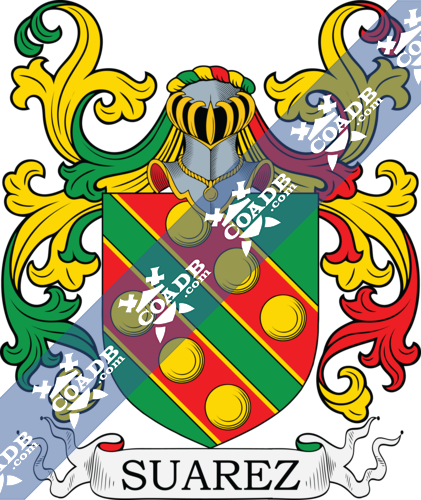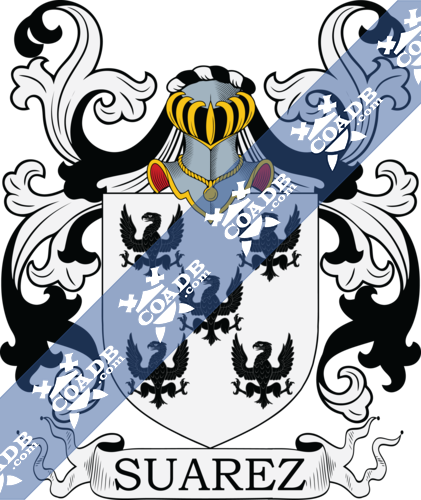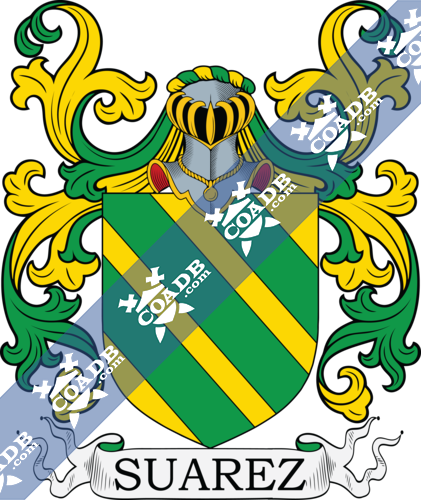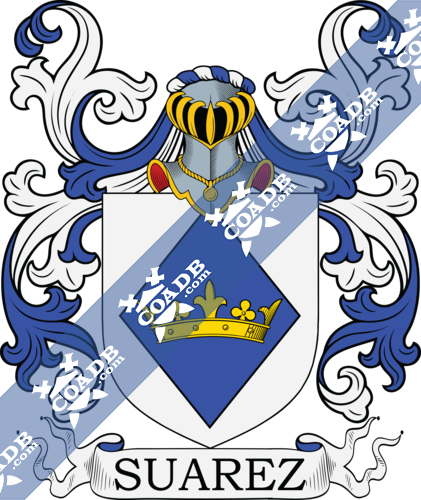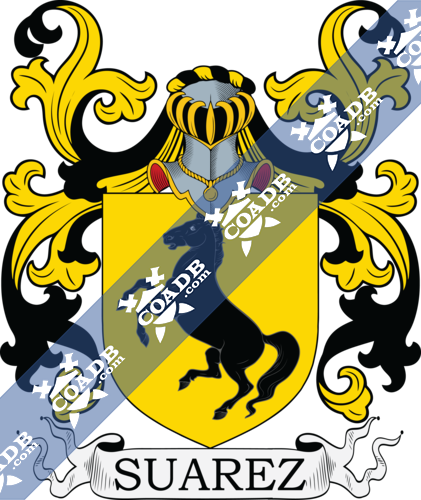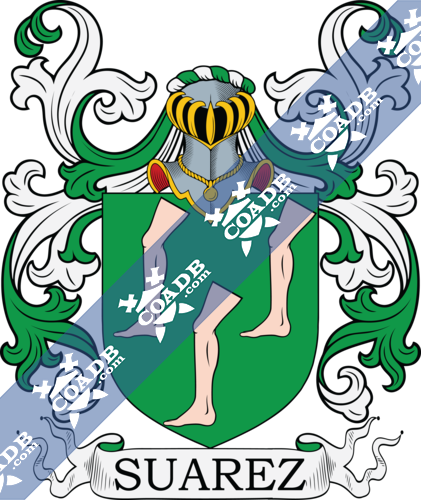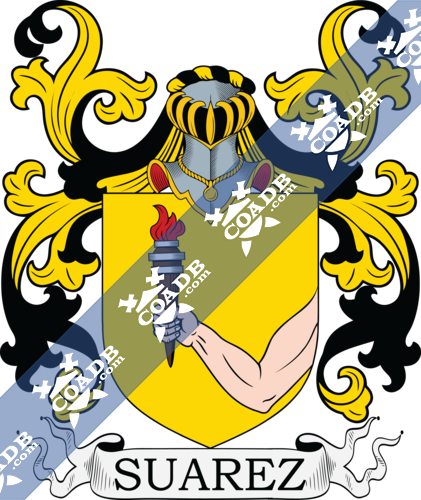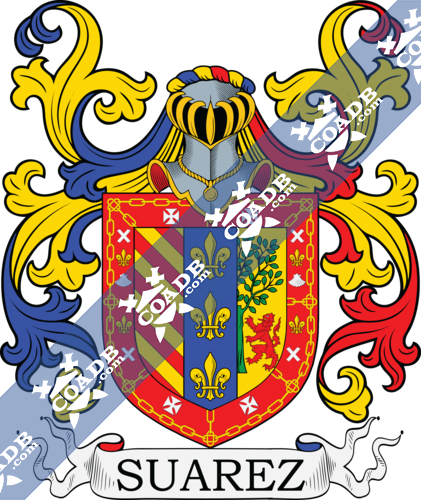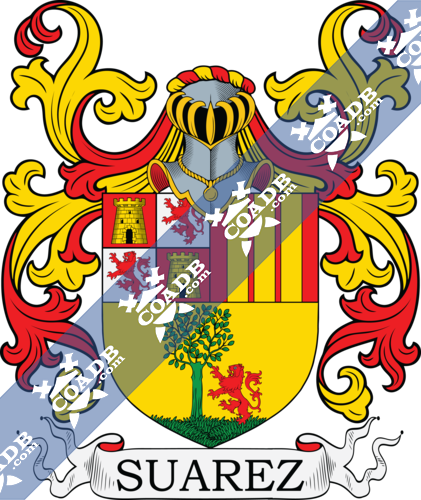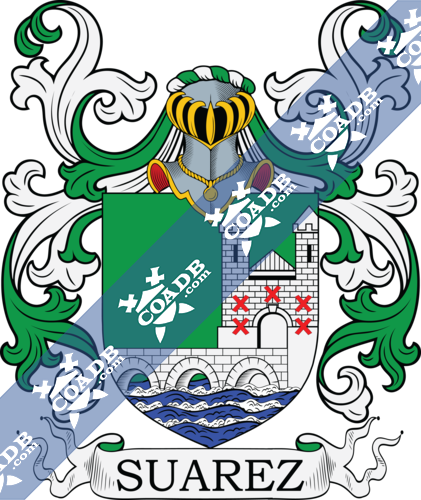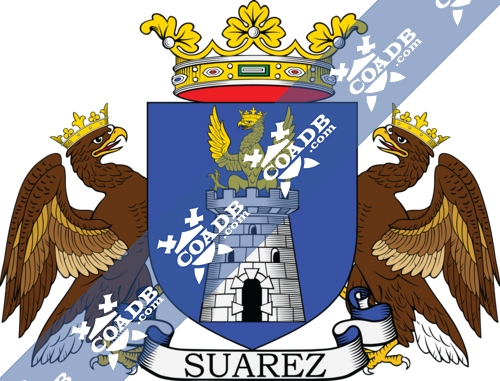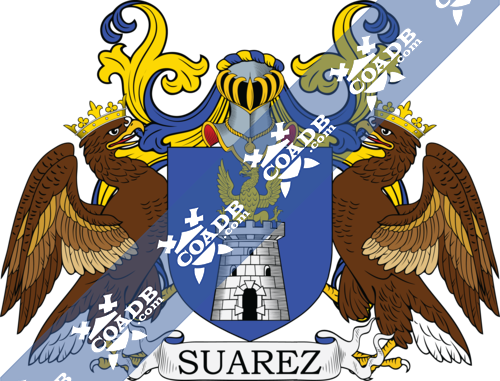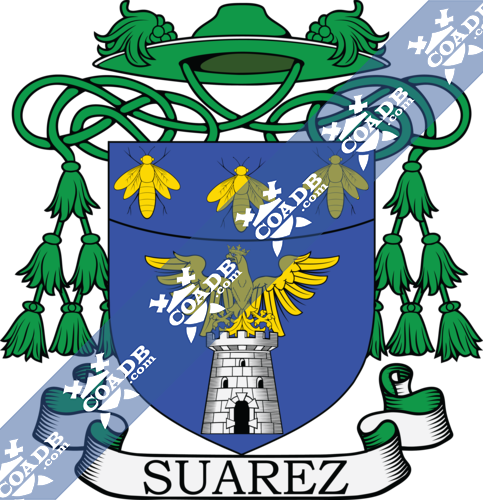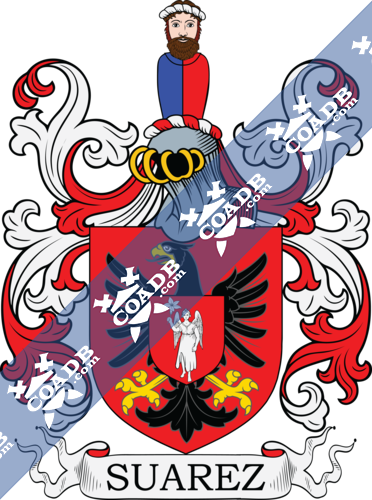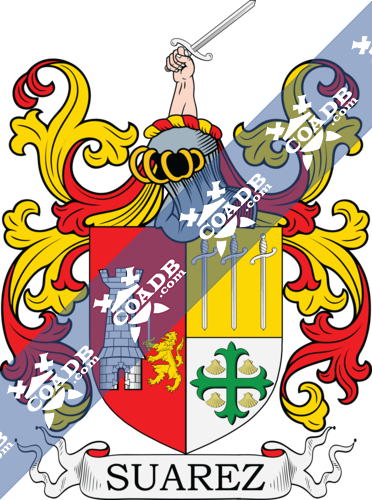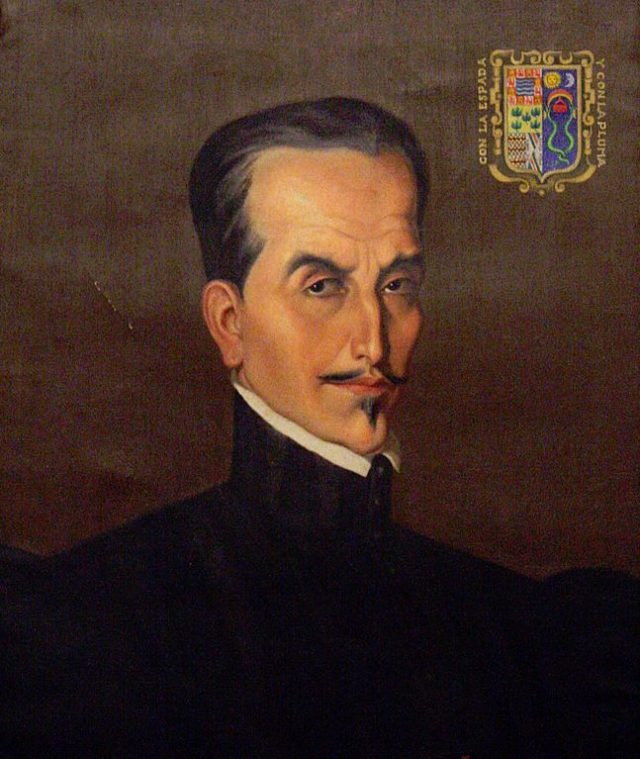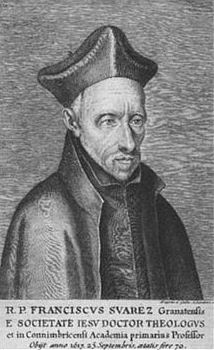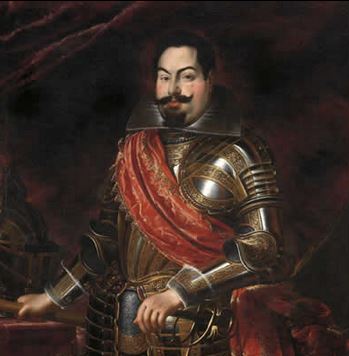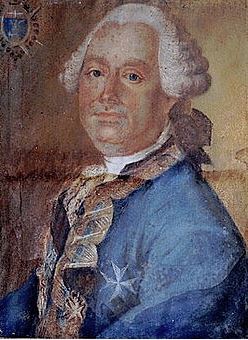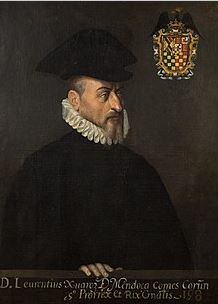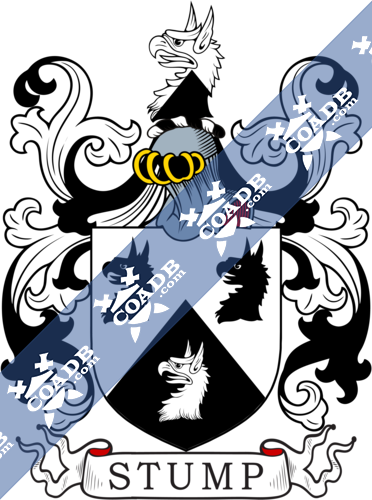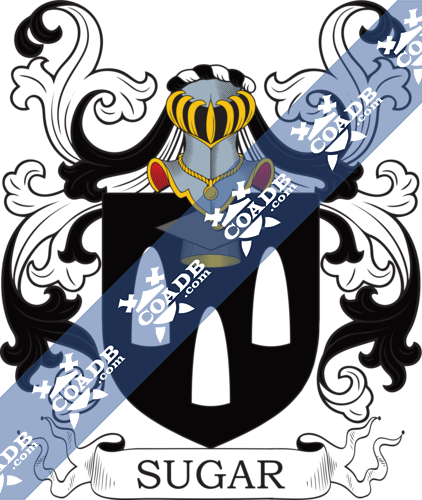Suarez Family Crest, Coat of Arms and Name History

Suarez Coat of Arms Gallery
Don’t know which Coat of Arms is yours?
We can do a genealogical research. Find out the exact history of your family!
Learn MoreSurname Meaning, Origin, and Etymology
Suarez is one of the thousands popular current surnames that come from the ancient country of Spain. It has its origin in a very wide cultural mix, thanks to the different societies that have occupied this territory over the centuries. The history of the last name Suarez begins in the 5th century AD when the Visigoths descended from what it is today Germany and then started to fight against the Roman Empire. This barbarian tribe, took several extensions of lands away from the Romans, as far as the Iberian Peninsula and specifically, Spain.
The Visigoths spent a lot of years in the Iberian Peninsula before they were expelled by the Muslims. However, even today they are still some traces of the culture of this Germanic barbarian tribe on the Spanish Territory, some traditions, costumes and one of perhaps the strongest trace of their society, their surnames.
Etymologically, this is a patronymic surname, which means that it is derived from the name of the father, of its first bearer. This is easily known, thanks to the suffix “ez”, which granted the meaning of “son of”, a feature of all of the Spanish surnames that has that ending. It came from the Latin word “suerius” which means, pig shepherd, then Suarez means “son of the pig shepherd”.
Nevertheless, this is not the only explanation for the meaning of Suarez. This is because, there is another theory that assigns to this Spanish last name another and completely different sense. This is because it is formed by two characters, “sur” which means south and “hari”, that can be translated as army. This would give the meaning of “army of the south” to Suarez, but it is not well established that its first bearers belonged to an “army of the south”.
Fortunately, there are good records that allow knowing some old bearers of Suarez. Actually, the first record talks about Benito Suárez, who died in 1208. This man was a knight who served King Alfonso XI de Leon during the Reconquest of many Spanish lands from the Muslims.
Spelling Variations
Spelling variations were very normal for medieval European surnames. This is thanks to several reasons, but the main motive was the mix of cultures that occurred in the old continent during this time. This fuse of societies happened all the time, especially after a war that changed the hand that controls a certain territory. The history of Suarez as a last name shows this aspect at all its periods, because is one of the memories that the Visigoths, left in Spain after defeating the Romans, and then they were driven out by the Muslims, so all of these cultures played a role in this surname.
A second reason was the fact that some branches of a family liked to be easily distinguished from others without any difficulty. This was done to express their loyalty o a certain lord, or that they followed a different religion than the rest of the family. In order to accomplish this goal, they recurred to the resourced of changing, adding or removing one or some letters of the family name.
Another reason that caused many spelling variations was wrong translations and writing mistakes. The first one occurred when a family name was translated from a language to another and some letters were taken or added, so a new variation was created. The second one was very common because not everyone in the Medieval Age knows how to write. Most of the writing was done by scribes, who sometimes the only reference they had to write a word was how it sounded, so they don’t always write a surname the same way every time they heard it. Thanks to all of these factors, Suarez counted on spelling variations like the following: Soeiro, Suero, Soares, Juarez, Juara, de Juara, Juares, Suárez, Suérez, Suerez and many other.
Popularity & Geographic Distribution
In the ranking of popularity of surnames, Suarez holds the 405th position and it counts on approximately, 1,209,923 bearers around the world. The nation with the highest count of users of Suarez is Colombia, followed by Mexico and Venezuela. This is not rare, because all of these countries, used to be part of the Spanish Empire, so its surnames were the first in arrival to these territories. The country with the highest density of Suarez is Cuba, an island that also used to be part of the Spanish Empire.
Early Bearers of the Surname
Thanks to the good records of the surname Suarez, is possible to know some of its early bearers, or at least its spelling variations, which also have a good portion of its popularity. These records mention: Hernando Juarez, at Nuestra Señora de la Antigua, Valladolid, Spain on November 24, 1556, Eusebia Suarez who became Christian in Valdecaballeros, Badajos, Spain on March 30th, 1616, Pedro Juara who got married to Juana Ponse at Santa Maria Magdalena, Valladolid, Spain on March 1st, 1671, Carvayo Juares, who became Christian at Aguilar de Campos, Valladolid, Spain, on May 23rd, 1752. Others example are: Isabel de Figueroa Suarez who became Christian on December 14ht, 1532 in Belacazaro, Ciudad, Spain ruled on that time by King Charles 1st of Spain, Emperor of Mexico, who was the main monarch from 1516-1556, Pero Suarez de Quiñones, who was a nobleman from Castilla during the fourteenth century, Juan Suarez de Peralta, a writer from Mexico during the Colonial period and Francisco Suarez, a theologian and philosopher from Spain in the sixteenth century.
History, Genealogy, and Ancestry
Chile count on good records about the genealogical tree of its inhabitants and thanks to that it is possible to know the members of those family chains. In the case of Suarez, there are good examples like Diego Suárez de Figueroa, who was the Belálcazar Castile on the Ciudad Real province. He got married to Constanza Gómez Murillo La Pareja. They had only one child, Lorenzo Suárez de Figueroa, who got married in 1527 to Catalina Ortiz de Gaete, daughter of Francisco Ortiz de Gaete and Leonor Gutierrez de Gaete.
Lorenzo and Catalina had six children, the first one was Diego Suárez de Figueroa y Ortiz de Gaete, who died in a trip to Peru and didn´t leave any children. Then, there was Francisco Suárez de Figueroa y Ortiz de Gaete, who became the Captain of the Araucho Castile, and like his elder brother did not have any children.
The third child was Juan de Villalobos Suárez y Ortiz de Gaete who became a public server and got married to Inés Mendoza Carvajal. This couple had four children of their own, Inés Mendoza Figueroa y Garcés, Marcos de Mendoza y Figueroa, Francisco de Mendoza y Figueroa and Marina Mendoza y Figueroa. The fourth child of Lorenzo Suárez de Figueroa and Catalina Ortiz de Gaete was Isabel Suárez de Figueroa y Ortiz de Gaete, who was born on December 14th, 1532 in Belálcazar. She got married to Lope Ruiz de Gamboa Bérriz, son of Andrés Lopez de Gamboa and Ana Navarra de Bérriz. The next child of this line was Lorenzo Suáres de Figueroa y Ortiz de Gaete but he didn’t leave any offspring.
The last child of Lorenzo Suárez de Figueroa and Catalina Ortiz de Gaete was Teresa Suárez de Figueroa y Ortiz de Gaete, who was born in Belálcazar, Ciudad Real and arrived in Chile with her aunt Marina Ortiz de Gaete. Teresa got married to Francisco de Riberos (spelling variation of Riveros) Figueroa, son of Alonso de Riveros and María Alvárez. Teresa and Francisco had only one child, Lorenzo Suárez de Figueroa y Riberos, who was born in 1557, became a Captain and got married in 1605 to María Alvarado y Cervantes, daughter of Carcía de Alvarado and Elvira de Figueroa. Lorenzo and María had seven children, they were: Jerónimo Alvarado, who got married to Andrea Rodríguez de Segovia y López, Pedro Suárez de Figueroa y Alvarado, who became a Captain and on June 8th, 1636, got married to Catalina Suárez-Narváez.
This last couple had seven children Lorenzo Suárez de Figueroa y Suárez-Narváez, Alonso Suárez de Figueroa y Suárez-Narváez, Pedro Suárez de Figueroa y Suárez-Narváez who got married to María Bustos de Lara Alfaro. Pedro and María had six children of their own, José Suárez de Figueroa y Bustos de Lara, Clara Suárez de Figueroa y Bustos de Lara, Antonia Suárez de Figueroa y Bustos de Lara, Margarita Suárez de Figueroa y Bustos de Lara, Josefa Suárez de Figueroa y Bustos de Lara and Lorenza Suárez de Figueroa y Bustos de Lara.
The following children of Pedro Suárez de Figueroa y Alvarado and Catalaina Suárez-Narváez were Juan Suárez de Figueroa y Suárez-Narváez, Francisco Suárez de Figueroa y Suárez-Narváez, Catalina Suárez de Figueroa y Suárez-Narváez and Antonio or Antonia Suárez de Figueroa y Suárez-Narváez.
Back to the line of the children of Lorenzo Suáres de Figueroa y Riberos and Maria de Alvarado y Cervantes, the others were Jerónimo de Riberos, Lorenzo de Figueroa, Catalina de Riberos, Teresa de Figueroa and María Alvarado y Figueroa. Lorenzo Suárez de Figueroa y Riberos had another child outside his marriage. He had it with Juana González and her name was Juana de Figueroa Riberos González.
Early American and New World Settlers
Just like what happened with other European surnames, Suárez arrived in America, thanks to the travels of the people from the old continent to the new one. The first bearers of Suárez of doing the trip in the 16th century were Gonzálo Suárez Rondon, who arrived at America in 1535, Ilán Suárez de Carvajal, who landed in Peru in 1540, Alvaro Suárez who arrived in Colombia in 1561, Francisco Suárez who did the same in Mexico in 1562 and María Suárez who arrived in Honduras in 1563.
In the 18th century Miguel Maria Suárez landed in Puerto Rico in 1796, then in the 19th century were the chance of Pablo Suárez, who also arrived at Puerto Rico in 1802, José Suárez who did the same at the next year, Pedro Suárez who landed in America in 1811, Catalina Suárez who also did it that same year and Mendo Suárez who did it in 1812.
Notables
There have been several bearers of the surname Suárez that have played a remarkable role in different fields. For example, Ema Suárez (b. 1964) a Spanish actress, Diego Suárez (1888-1974) an American garden designer, Claudia Suárez (b. 1987) a supermodel from Venezuela, Cecilia Suárez (b. 1971) a Mexican actress, Gonzalo Suárez (b. 1934) a writer, screenwriter and producer from Spain, Eduardo Aldasoro Suárez (1894-1968) a Mexican aviation pioneer, Gastón Suárez (1929-1984) a Bolivian writer, Bobby A. Suárez (b. 1942) a Filipino film director, Aurelio Suárez (1910-2003) a surrealist painter from Spain, Gómez Suárez de Figueroa (153-1616) a Peruvian historian and writer, Karla Suárez (b. 1969) a Cuban writer and Virgil Suárez (b. 1962) an American novelist, poet and professor.
Blazons & Genealogy Notes
2) Marquis d’Aulan – Comtat-Venaissin – Parti au 1 de gueules à deux lions affrontés d’or au 2 d’or à un griffon d’azur Per pale 1st gules two lion affrontant [face to face] or 2nd or with a griffin azure.
3) Espagne – Tiercé en pal au 1 coticé en bande d’or et de gueules de dix pièces au 2 d’azur à trois fleurs-de-lis d’or rangées en pal au 3 d’or à un arbre de sinople mouv de la division senestré d’un lion de gueules rampant contre le fût L’écu entouré d’une bordure de gueules ch de chaînes d’or en orle en sautoir et en croix formant huit compartiments les deux en chef et les deux en pointe ch chacun d’une croisette pattée d’argent les deux compartiments supérieurs des flancs ch chacun d’un flanchis d’argent d’une fleur-de-lis d’or et d’une coquille d’argent rangés en pal et les deux compartiments inférieurs des flancs ch chacun d’une fleur-de-lis d’or et d’un flanchis d’argent l’un sur l’autreTierced palewise 1st cotticed [bendy] bendwise or and gules of ten pieces 2nd azure three fleur de lys or arranged palewise 3rd or with a tree vert coming from the division having to the sinister a lion gules rampant against the trunk the shield entirely within a bordure gules charged with chains or in orle saltirewise and in cross forming eight areas the two in chief and the two in base charged with each a crosslet pattee argent the two upper areas of the flank charged with each a saltorel argent a fleur de lys or and an escallop argent arranged palewise and the two lower areas of flank charged with each a fleur de lys or and a saltorels argent in pale.
4) Suarez-Camberos – Andalousie – Coupé au 1 parti a écartelé de gueules à une tour d’or et d’argent au lion de gueules b de gueules à trois pals d’or au 2 d’or à un arbre terrassé de sinople senestré d’un lion de gueules rampant contre le fût de l’arbrePer fess 1st per pale a) quarterly gules with a tower or and argent of lion gules b) gules three palets or 2nd or with a tree on a mount vert having to the sinister a lion gules rampant against the trunk of the tree.
5) d’Almeida – Portugal, Toulouse – D’azur à une tour d’argent maçonnée ouverte et ajourée de sable et surmontée d’une aigle d’or couronnée à l’antique du mesme Couronne de duc Supports deux aigles couronnées Devise UNICUIQUE SUA RESAzure with a tower argent masoned doorways and openings sable and surmounted by an eagle or crowned ancient of the same the shield urmounted by a ducal coronet Supporters two eagle crowned Motto: UNICUIQUE SUA RES.
6) d’Aulan – Comtat-Venaissin – Ex-Libris du XVIIIè siècle (1730) – D’azur à la tour d’argent maçonnée ouverte et ajourée de sable surmontée d’une aigle d’or couronnée à l’antique du même Supports deux aigles couronnées Devise UNICUIQUE SUA RESAzure with a tower argent masoned doorways and openings sable surmounted by an eagle or crowned ancient of the same Supporters two eagles crowned Motto: UNICUIQUE SUA RES.
7) d’Aulan – Comtat-Venaissin – (Coll. Quantin) – Un portrait (1669) de Joseph-Marie de évêque de Vaison vicaire de Saint-Pierre de Rome et camérier secret du Pape Urbain IV en 1633 présente une curieuse variante des armes de la famille de Suarez par l’adjonction d’un chef arrondi d’azur à trois abeilles d’or qui sont les armes des Barberini celles du Pape Urbain IV qui en fil certainement concession au prélat son conseiller Les armes sont placées sous un chapeau ecclésiastique à trois rangs de houppeA portrait (1669) of Joseph-Marie the Bishop of Vaison, vicar of St.Peters in Rome and camerlengo of Pope Urbain IV in 1633 presents a curious variant of the arms of the family of Saurez by the addition of a chief arched azure with three bees or which are the arms of the Barberini those of Pope Urbain IV Above the shield is placed an Ecclesiastical hat with three rows of tassels. I think the hat should be vert, see link – https://fr.wikipedia.org/wiki/Joseph_Marie_de_Suar%C3%A8s
8) d’Aulan – Comtat-Venaissin – De sinople à un pont de trois arches d’argent mouv du flanc dextre conduisant à une chapelle du second mouv du flanc senestre et ch sur la façade de cinq flanchis de gueules 1 2 et 2 les deux derniers accostant la porte le tout s’élevant d’une eau d’azur agitée d’argentVert with a bridge of three arches argent coming from the flank dexter heading towards a castle of the second coming from the flank sinister and charged with over the front with five saltorels gules 1 2 and 2 the two last either side of the door all rising from the water azure with curling waves argent.
9) de Andallon – Asturies – Parti au 1 de gueules à une tour d’argent posée à dextre ouverte et ajourée du champ senestrée d’un lion rampant d’or tenant de ses pattes une épée d’argent garnie d’or en pal la pointe en bas au 2 coupé a d’or à trois épées d’argent garnies du même rangées en fasce les pointes en bas b d’argent à la croix florencée de sinople cantonnée de quatre coquilles au naturel Cimier un avant-bras de carnation posé en pal brandissant une épée d’argent garnie du même Lambrequin d’or et de gueules Devise QUOD VIBRARE MANU NON FRUSTRA SCIVERIT ENSEMPer pale 1st gules with a tower argent placed to the dexter doorways and openings of the field having to the sinister a lion rampant or holding in its paws a sword argent hilt and pommell or palewise the base downwards 2nd per fess a) or three sword argent hilt and pommell of the same arranged fesswise the points downwards b) argent with the cross flory vert having in each quarter four escallops proper Crest: a fore-arm carnation placed palewise brandishing a sword argent hilt and pommell of the same Mantling: or and gules Motto: QUOD VIBRARE MANU NON FRUSTRA SCIVERIT ENSEM.
10) de Ovalle – Milan – Coupé au 1 parti a huit points de gueules équipollés à sept de vair b d’or à deux loups passants de sable l’un sur l’autre au 2 d’azur à trois pals dentelés d’argent L’écu entouré d’une bordure d’argent ch de huit écussons chaque écusson tiercé en pairle renversé et ployé a de gueules à une tour d’or sommée de trois tourelles du même ouverte et ajourée d’azur b comme a c d’argent au lion de gueulesPer fess 1st per pale a) checky of eight squares gules and seven vair b) or two wolf passant sable in pale 2nd azure three palets indented [on one edge] argent the shield entirely within a bordure argent charged with eight escucheons each escucheon tierced [tripled] reversed and curved a) gules with a tower or surmounted by three turrets of the same doorways and openings azure b) same as a) c) argent a lion gules.
11) de Quiñones Osorio – Espagne – De gueules à l’aigle éployée de sable becquée et membrée d’or portant sur son estomac un écusson de gueules ch d’un ange d’argent tenant de sa main dextre un lis d’argent la senestre appuyée sur sa hanche Cimier un buste d’homme tortillé d’argent habillé d’un parti d’azur et de gueulesGules with an eagle displayed sable beaked and legged or carrying on its chest an escucheon gules charged with an angel argent holding in her dexter hand a lily argent the sinister resting on her hip Crest: a bust of a man wreathed argent dressed a per pale azure and gules.
12) della Conca – Florence – D’azur à une tour d’argent maçonnée ouverte et ajourée de sable et surmontée d’une aigle d’or couronnée à l’antique du même. English: Azure with a tower argent masoned doorways and openings sable and surmounted by an eagle or crowned ancient of the same.
13) Los de Santander, Asturias y León, traen: En campo de oro, dos torres de piedra, puestas en faja sobre una terrasa de sinople, y saliendo de cada torre, un águila volante, de sable; las dos águilas afrontadas. English: Or, on a teracce in base vert two towers proper, on each an eagle sable flying away from the battlements.
14) Otros, traen: En campo de oro, dos torres de piedra puestas en faja, con sus almenas sumadas de un águila de sable. English: Or, on a teracce in base vert two towers proper, each surmounted by an eagle displayed sable.
15) Los de Castilla, traen: En campo de plata, una fuente al natural superada de un sauce de sinople. English: Argent, in base a fountain propper, surmounted by in chief a willow tree vert.
16) Otros traen: En campo de plata, una cruz hueca y floreteada, de gules. Bordura de gules con ocho aspas de oro. English: Argent a cross flory voided, around the whole shield a bordure Gules charged by eight saltiers Or.
17) Originario de Asturias y radicado en Talavera: En campo de gules, seis roles, de plata, puestos en dos palos. English: Gules, six plates arranged in two suits of three, palewise.
18) Los de Puerto Rico, traen: En campo de plata, cinco calderas, de sable, en aspa: Bordura de gules con ocho aspas de sable. English: Argent, five caldrons sable saltirewize, the whole shield inside a bordure gules, charged by eight saltires sable.
19) Los de Andalucía, traen: Escudo cuartelado: 1º, y 4º, de gules, cinco flores de lis, de plata; 2º y 3º, en gules, cuatro fajas, de plata.English: Quarterly – 1st and 4th: Gules, five fleur-de-lis argent saltirewize; 2nd and 3rd: Gules, four bars argent.
20) Otros de Asturias, en el Palacio de los Cabos (Pravia), de los Suárez Miranda, vemos: En campo de oro, dos castillos de piedra, sobre ondas de azur y plata, sumados cada uno de un águila de sable. Debajo de las ondas de agua, y en la forma que se ve en el dibujo, una pradera de sinople. English: Or, upon waves of Azure and Argen two castles tripple towered proper, the midle tower of each surmounted by an eagle displayed sable. Under the waves, issuing from the base sinister, a meadow vert
21) Originario de San Pedro de Andeis: En campo de oro, tres lises, de azur, puestas dos y una. English: Or three fleur-de-lis Azure – arranged two and one.
22) Radicado en Valladolid: En campo de sinople, dos bandas de gules, perfiladas de oro y cargadas cada una de ellas, de tres roeles de oro. English: Vert two bends gules edged or, each charged by three bezants.
23) Radicado en Vélez Málaga: En campo de plata, cinco águilas, de sable, puestas en aspa. English: Argent, five eagles displayed sable saltirewize.
24) Radicado en Aspera (Orense) y extendido a Pontevedra y Vigo: En campo de azur, tres estrellas, de oro, puestas en banda.English: Azure three mullets Or in bend
25) Radicado en Sena: En campo de oro, tres bandas, de sinople. English: Or, three bendlets Vert.
26) Radicado en Maracaibo (Venezuela): En campo de plata, un losange, de azur, cargado de una corona, de oro. English: Argent, a lozenge Azure, charged with an ancient coronet Or.
27) Asturiano, radicado en Oviedo y pasado a Honduras: En campo de oro, un caballo, de sable, en posición de salto. English: Or, a horse rampant sable
28) Radicado en Orense y extendido a La Coruña y Pontevedra: En campo de sinople tres piernas, de carnación, puestas dos y una. English: Vert, three legs carnation, arranged two and one.
29) Radicado en Pobladura del Valle: En campo de oro, un brazo al natural saliendo por el flanco siniestro con una antorcha en su mano. English: Or, coming out from the sinister flank an arm carnation, holding a torch proper.

